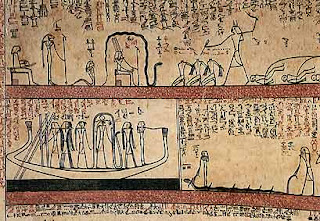With these questions I think we can address a lot of the comments commonly made about slavery in Ancient Egypt. I am actually going to address these questions in reverse of how I listed them above.
How did someone become a slave in Ancient Egypt?
The most common way was probably prisoner of war. Egyptian history shows that often the soldiers of defeated armies became slaves. Most were used as laborers or as house servants.
The second most common method was likely debt. Debt slaves were more like the concept of indentured servants in Europe where someone would work as a slave/servant until the debt had been paid. Debt slaves did not lose their rights due to their service.
By birth the children of a slave, particularly debt slaves who had not paid off the debt, would remain slaves until the debt was paid or the terms of the slavery was fulfilled.
Punishment! Pharaohs, Viziers and the like could give forced labor as a punishment for a crime.
Voluntary slavery. We might not even call this slavery by modern terms. Families or individuals would give themselves, their families or their children into service of an individual. Those taking them on as slaves would provide them with protection and give economic stability to the people. Usually these individuals would pay so much to their "owner" for a set period of time at a set rate. As far as I have read these individuals also kept their rights as citizens.
The slave trade of other nations brought slaves into Egypt and they were sold or given as tribute. There were no slave markets in Egypt through most of its history as existed in many other parts of the ancient world. Slave trades were usually for specific skills; dancers, weavers, people who spoke extra languages, craftsmen or on occasion a noble or pharaoh searching for exotic looks.
How is slavery defined by Egypt and ourselves?
In modern times we identify slavery as being owned, forced to toil, abuse, domination and persons as property. Our modern definitions would be on par with how Romans, for example, felt about slaves.
The Egyptians however did not feel the same about slavery. Slaves in Egypt often, more often than not, kept their civil rights. Slaves were also often freed for various reasons. Decent treatment of those in service (and slaves) is written in the moral conduct of the religion. Treating a slave well in Ancient Egypt was part of judgement and the weight of the heart on the scales. In addition, freeing a slave after a fair amount of work had been done was written as a boon for the heart at judgement as well. Egyptian slaves did not all toil on temples. Anything from a field worker to a tax collector; watchmen to temple members could be the duty of a slave. Egyptian slaves could also own property, their own businesses and personal possessions which is contradictory to many of the modern ideas of slavery. Slaves could perhaps marry and definitely co-habitate with both slaves and non-slaves in committed unions with the allowances of the master. Slaves maintained legal rights as well and could speak up as witnesses or in their defense if accused of a crime. Egyptian slaves also could have higher status than free Egyptians. For example, the slave of a temple high priest that was say in charge of ensuring the temple always had enough incense could easily have a higher stature in the Egyptian society than a free field worker. The final interesting tidbit about Egyptian slaves is often the Mistress of the House (ie the owner's wife) would care for and raise the slave children because children were not permitted to be used for labors of adults. It was also forbidden for a master to sell the children or spouses of a union he had sanctioned as ok. Egyptian slave families were rarely broken up aside from grown children being gifted or sent to other locations to work.
Another problem with the word slave in Ancient Egypt is that there is little difference between the usage of slave and servant. For example, priests would interchangeably call themselves slaves and servants of their god. Also, all bets were off when outsiders took over Egypt, particularly the Greeks who brought large numbers of slaves and increased the use of Greek style, more modern style, slavery into Egypt.
It leaves the question of how much slavery was in Egypt by modern standards? Was any of this even slavery by our understanding of the word? This is still something that is contested in research but more and more there is a leaning toward less examples of slavery in Egypt based on our modern understanding of the word compared to how these Egyptians lived.
Some sources for identification of slaves and the life of a slave in Egypt include:
The Dictionary of Ancient Egypt
Grimal's History of Ancient Egypt
Romer's History of Ancient Egypt
Life of the Ancient Egyptians
The Oxford History of Ancient Egypt
The Oxford Encyclopedia of Ancient Egypt
Ancient Egypt: Anatomy of a Civilization
Some on the Slavery in Egypt during Roman times.
The Pyramid Builders of Ancient Egypt: A Modern Investigation of Pharaoh's Workforce
The next post I will tackle the idea of slaves as pyramid and temple builders which will be closely related to that last book about the pyramid builders. I would have included it here but I think this post is quite long enough.



.JPG)

















